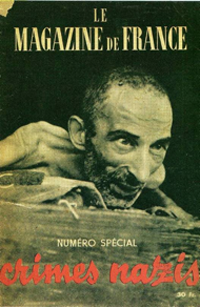4. Photography serving information on crimes against Humanity in Nazi camps
4a. Photograph of the American army made at Ohrdruf
 Click image to enlarge
Click image to enlarge
4b. Eric Schwab at Buchenwald, « dysentérique mourant »
 Click image to enlarge
Click image to enlarge
Presentation 4b
Eric Schwabb (1910-1977) was a reporter and a photographer in Paris during the war. The anti-Jewish laws prevent him from working during the Occupation. He managed to escape arrests but his mother was deported. In September 1944, he became a correspondent for the French Agency of Press. He covered, with the American army, events of the end of the war with the camps’ liberation of Buchenwald and Dachau. Numerous photographs made by Eric Schwab were published in the press. Some, as the dying man, became symbols of deportees’ sufferings. “In each camp, Schwab took more pictures of survivors than dead people…By isolating the survivors and photographing close up sometimes in a slight dive-cons, he seemed to have wanted them to emerge from the anonymous mass of the destroying universe of the camp…As a son of deportee, he certainly saw through these survivors the martyr of his own mother.1” (Clement Cheroux, Mémoire des camps, Marval, 2001).
1 He found her at the Theresienstadt camp in July 1945.
4c. A photograph taken by the American army near Dortmund
 Click image to enlarge
Click image to enlarge
Presentation 4c
German civilians are watching at a panel on which are displayed photographs showing atrocities made at Gardelegen where, on the 12th of April 1945, SS and Hitler Youth massacred more than a thousand of deportees coming from Dora’s and Neuengamme’s camp.
Questions
Links
- History Center of the Resistance and Deportation website (Lyon, 69): http://www.chrd.lyon.fr/chrd/sections/fr/
- Museum of the National Resistance website (Champigny, 94): http://www.musee-resistance.com/
- Museum of the Resistance and Deportation of Picardie (Tergnier, 02): http://www.resistance-deportation-picardie.com/content/view/9/11/
Answers
- The first document (The Illustrated London News) was published in England on Saturday, April 28, 1945. The second document (n° spécial du Magazine de France) was published in France on May 1945. Both documents are covers that reproduce photographs taken during the liberation of Nazi camps:
- The English newspaper shows a photograph taken by the American army on which we can see, in the foreground, the general Eisenhower circled by soldiers watching deportees’ corpses.
- The French magazine reproduces a photograph showing a close-up of an emaciated face of a prisoner of Buchenwald.
- While the first photograph taken by the press service of the US military showing faces of liberators during a visit to a camp, the second photograph taken by Eric Schwabb “embodies” the physical destruction of a man whose face and eyes stood out against a dark background.
- The winners made thousands of German, who were living near, visit the camps so they saw by themselves the atrocities that were committed (cf. supra). However, the majority of Germans were unable to visit the camps. Therefore, photographs taken in camps were exhibited in German cities on panels designed for this purpose. The German press published, under Allies control, was also an important means to disseminate images of the camps. This was to establish a “pedagogy of horror” for striking opinion and contribute to the “denazification”2
2 Clément Clément Chéroux, « L’épiphanie négative : production, diffusion et réception des photographies de la libération des camps » in Mémoire des camps, Marval, 2001.




Presentation 4a
The title, that accompanies the photograph, underlines that the general Eisenhower “usually warm” expresses, by his attitude, the horror of “German brutality”. The author of the comment describes the horrified attitude of the American general when he saw the 31 corpses of prisoners, murdered by the SS of the Ohrdruf camp. He says that near the camp, they discovered many other corpses, some burned of quicklime. He informs his readers that the US military have forced German civilians to be “witnesses to these horrors”.